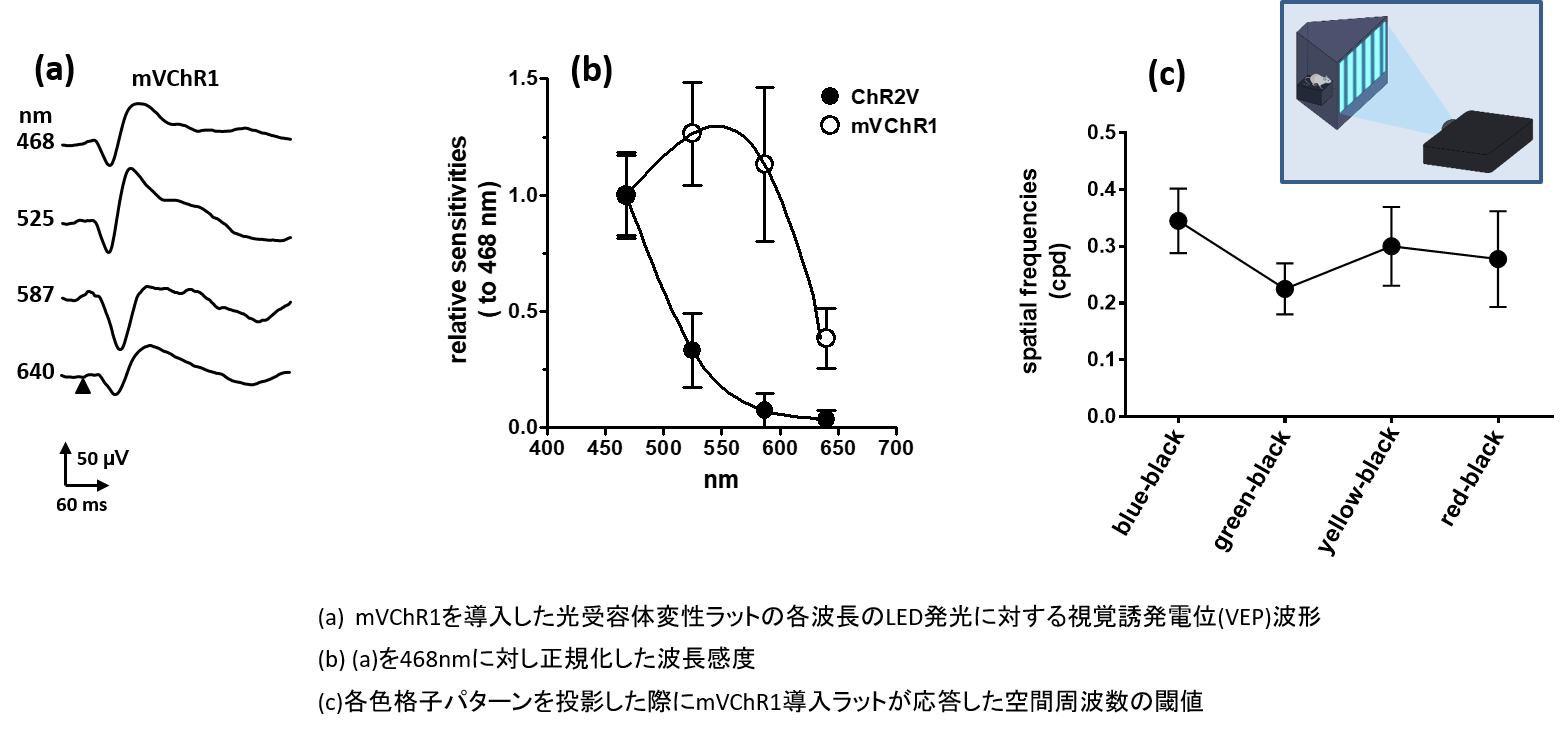網膜色素変性症によって障害された網膜の視細胞の代わりに、
神経節細胞に緑藻類ボルボックス由来のチャンネルロドプシン-1遺伝子(mVChR1)を導入することで
光受容機能を持たせ、脳に視覚情報を伝達することで視力を回復する遺伝子治療です。
神経節細胞に緑藻類ボルボックス由来のチャンネルロドプシン-1遺伝子(mVChR1)を導入することで
光受容機能を持たせ、脳に視覚情報を伝達することで視力を回復する遺伝子治療です。
- 神経節細胞が維持されていれば、視細胞の再建を必要としません。
- 白黒画像ながら青~赤までのすべての色を感知可能です。
- 単回の遺伝子導入で実現され患者への負担は軽減されます。
- 導入ベクターとしてアデノウイルスを用いるため高・安全性です。

特許及び関連論文
特許
- 出願日:2009/8/10, 日PCT/JP2010/063786, 特願2009-185455, 発明の名称:発現効率が改善された光受容チャネルロドプシン
- Date of Patent Jun.17, 2014, Patent No: US 8,754,048B2, Title: Light-receiving channel rhodopsin having improved expression efficiency.
論文
- Invest Ophthalmol Vis Sci. 2007 Aug;48(8):3821-6 “Visual responses in aged dystrophic RCS rats were restored by AAV-mediated channelopsin-2 gene transfer.” Tomita H, et al.,
- 臨床眼科 増刊号 網膜硝子体診療 update 医学書院, 第62巻 11号, 2008, p336-341 「チャネルロドプシン」冨田浩史 他
- PLoS ONE, November 2009, Volume 4, Issue 11, “Visual Properties of Transgenic Rats Harboring the Channelrhodopsin-2 Gene Regulated by the Thy-1.2 Promoter.” Tomita H, et al.,, Wang H, Sugiyama Y, Hikima T, Sugano E, Tomita H, Takahashi T, Ishizuka T, Yawo H
- The Journal of Biological Chemistry, 2009 Feb 27;284(9):5685-96. Epub 2008 Dec 22. “Molecular determinants differentiating photocurrent properties of two channelrhodopsins from chlamydomonas.”
- Experimental Eye Research, 2010 Mar;90(3):429-436. Epub 2009 Dec 27., “Channelrhodopsin-2 gene transduced into retinal ganglion cells restores functional vision in genetically blind rats.” Tomita H, et al.,
- Journal of Genetics, 2009 Dec;88(4):409-15. “Channelrhodopsins provide a breakthrough insight into strategies for curing blindness.” Tomita H, et al.,
- PLoS One. 2009 Nov 5;4(11):e7679. “Visual properties of transgenic rats harboring the channelrhodopsin-2 gene regulated by the thy-1.2 promoter.” Tomita H, et al.,
- J Genet. 2009 Dec;88(4):409-15. Review. “Channelrhodopsins provide a breakthrough insight into strategies for curing blindness.” Tomita H, et al.,
- Exp Eye Res. 2010 Mar;90(3):429-36. Epub 2009 Dec 27. “Channelrhodopsin-2 gene transduced into retinal ganglion cells restores functional vision in genetically blind rats.” Tomita H, et al.,
- PLoS One. 2010 Nov 29;5(11):e15009. “Dissecting a role for melanopsin in behavioural light aversion reveals a response independent of conventional photoreception” Semo M, Gias C, Ahmado A, Sugano E, Allen AE, Lawrence JM, Tomita H, Coffey PJ, Vugler AA.
- Gene Therapy 2011, 18(3) 266-74. “Immune responses to adeno-associated virus type 2 encoding channelrhodopsin-2 in a genetically blind rat model for gene therapy.” Sugano E, Isago H, Wang Z, Murayama N, Tamai M, Tomita H.
- J Mol Neurosci. 2012 Feb;46(2):393-400. Epub 2011 Jul 27. “Age-Dependent Differences in Recovered Visual Responses in Royal College of Surgeons Rats Transduced with the Channelrhodopsin-2 Gene.” Isago H, Sugano E, Wang Z, Murayama N, Koyanagi E, Tamai M, Tomita H.
- PLoS One. 2013 Apr 10;8(4):e60928. doi: 10.1371/journal.pone.0060928. Print 2013. “Optogenetically induced seizure and the longitudinal hippocampal network dynamics.” Osawa S, Iwasaki M, Hosaka R, Matsuzaka Y, Tomita H, Ishizuka T, Sugano E, Okumura E, Yawo H, Nakasato N, Tominaga T, Mushiake H.
- BMC Ophthalmol. 2013 May 17; 13:19. doi: 10.1186/1471-2415-13-19. “Establishment of monocular-limited photoreceptor degeneration models in rabbits.” Isago H, Sugano E, Murayama N, Tamai M, Tomita H.
- Mol Ther. 22(8):1434-40.2014. “Restoration of the majority of the visual spectrum by using modified Volvox channelrhodopsin-1.” Tomita H, et al.,


